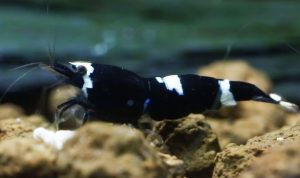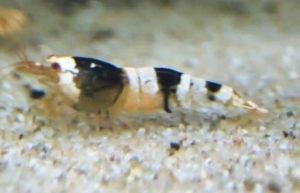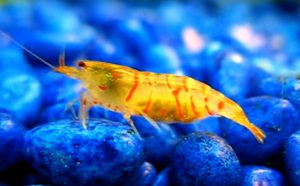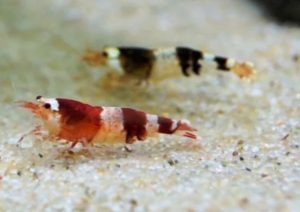The Bee Shrimp (Caridina cf. cantonensis) is a species of small freshwater filter feeders that is native to mainland China, Hong Kong and the New Territories, Malaya and Japan that has become the latest craze for tropical fish keeping enthusiasts.
In the wild, Bee Shrimp live in the moderate to faster flowing mountain streams and rivulets of their range in clean, soft,slightly acidic (pH 6.5), well oxygenated water, where they feed on small pieces of decayed vegetation and algae.
Wild Bee Shrimp (Caridina cf. cantonensis) have a clear body with a broad rough pattern of brown to black splotches and white stripes.
A second wild variety known as the Tiger Shrimp also exists that has a transparent body with thin dark bands.
All of the other existing bee shrimp color strains and patterns that we have available today were selectively bred from these two Asian populations.
Around mid 1990, a Japanese Bee Shrimp breeder named Hisayasu Suzuki discovered that a few specimens in his wild population were slightly reddish in color. By selectively breeding these specimens over the course of several years, he developed the first Red Crystal Shrimp.
When these dwarf shrimp became available to tropical fish keeping enthusiasts, breeders continued to selectively refine the initial strain to improve the delineation of patterns, the clarity of the color, and the overall coverage of the white stripes on the shrimp. Since then, importers and breeders from all over the world have been introducing new stocks, species, and color morphs for hobbyists to the point that new strains seem to be appearing almost every month. Shrimp breeders have given colourful names to the many variants of the bee shrimp such as the Princess Bee, Blue Bolt, Tangerine Tiger, Snow White, Black Bee, Golden Tiger, Blue Tiger, Black Safari Tiger
, Shadow Panda, etc. some of which are pictured below:
With over a dozen variants available today to tropical fish keeping enthusiasts, Caridina cf. cantonensis is definitely one of the most diversified of the many available species of dwarf Bee Shrimp.
Unlike their more adaptable cousins the Red Cherry Shrimp (Neocaridina heteropoda), Caridina cf. cantonensis are intolerant of swings in pH, extremely susceptible to toxins in the water, and in general will only thrive in a much narrower range of water quality conditions.
Although the Bee Shrimp is more challenging to care for than Neocaridina heteropoda, the dozens of stunning variations make them highest on the list for tropical fish keeping enthusiasts interested in keeping peaceful nano tanks and selective breeding projects.
Bee Shrimp (Caridina cf. cantonensis) are best kept in a mature planted aquarium of 10 gallons or less, with a sandy or fine gravel (pH neutral) substrate, a bubble up sponge or small hang on filter with a sponge prefilter, some Java Moss or Najas, and a small piece of aged bogwood
. All dwarf shrimp species require good filtration with either 10% weekly water changes, or 25% bi-weekly water changes.
Most Bee Shrimp and Crystal Shrimp require soft, low pH water, however, Caridina shrimp collected from Sulawesi need a higher pH, higher alkalinity, and higher water temperatures. Reverse osmosis or deionized water with additives is often used to keep Caridina cantonensis and other soft water species.
NEVER introduce any species of dwarf shrimp into a newly set up aquarium. Aged systems are more stable and have natural food sources like algae for the dwarf shrimp to feed on.
Although most tropical fish keeping enthusiasts set up small nano shrimp only tanks, small, non aggressive species like the emerald dwarf rasbora, Boraras rasbora, celestial danio, ember tetra, Endlers livebearer, sparkling gourami, blue eyed rainbowfish, otocinclus, or pygmy corydora catfish can be safely housed with Bee Shrimp. Nerite
and several other small snail species can also be safely housed with them.
To prevent cross breeding, avoid combining different species of the same genus of dwarf shrimp in the same tank. You can usually keep Caridinia with Neocaridinia together, but don’t keep two species of Caridina together unless you are trying to create a new strain.
As long as you can keep your Bee Shrimp alive, breeding them is simply a matter of obtaining both sexes. Female Bee Shrimp are larger than males, more robust, and possess a more convex underbelly. Female non opaque varieties are easily sexed by the presence of saddle shaped ovaries directly behind the head of the shrimp.
If both sexes of Bee Shrimp are present and the female is fertile and has just molted, she will produce pheromones that causes the males to swim frenziedly around the tank searching for her. After mating and the eggs are fertilized, the female sticks them onto her swimmerets on the underside of her tail where she will carry them for the next month or so. Females during this period are called “berried females” and will continuously fan her swimmerets to create a flow of oxygenated water over her eggs until they hatch out.
Once hatched out, the newly hatched Bee Shrimp are left to fend for themselves. As long as no predatory fish are in the aquarium, the fry will do just fine as the parents will not destroy their offspring. And, as long as the water quality in the tank remains clean and stable, the existing food in the aquarium is normally sufficient to achieve a high survival rate.
Dwarf freshwater Bee Shrimp shrimp are primarily algae eaters, but they are great cleaners and will eagerly accept a variety of prepared foods such as Spirulina Flakes, algae rounds, shrimp pellets, bottom feeder flakes or tablets, tropical color enhancing flakes
, etc. Feed them only what they can consume in 3 or 4 minutes a couple times a day. Many breeders let them fast one day out of the week so they can clear out their digestive systems and clean up their tank.
Dwarf Bee Shrimp (Caridina cf. cantonensis) are active and almost continuously engaged in harvesting algae, cleaning up around their surroundings, or engaging in breeding activities.
The Crystal Red variety of Bee Shrimp is the most common and are far more readily available from tropical fish keeping stores on the Pacific Coast than on the Atlantic, however, the more exotic varieties are much more readily available from online Internet retailers, invert breeders, aquarium clubs, and auction sites, than from any brick and mortar shop.
Prices will vary from just a few dollars for the lower grades of more common varieties, to hundreds of dollars for the rarer high grade variants.
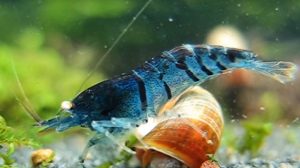
Blue Tiger Shrimp (Caridina cf. cantonensis)
Minimum Tank Size: 5 gallons
Care Level: Difficult
Temperament: Peaceful
Water Conditions: 68-74° F, KH 3-10, gH 4-6, pH 6.2-6.5
Max. Size: 1 3/4″
Color Form: Opaque, Red, Yellow, Blue, Black, White
Diet: Omnivore
Compatibility: Excellent cleaners
Origin: China, Hong Kong, Malaya, Japan
Family: Atyidae
Lifespan: 18 months
Aquarist Experience Level: Advanced



